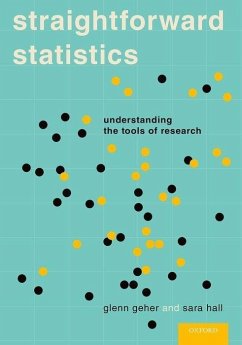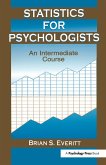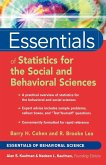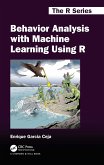Schade – dieser Artikel ist leider ausverkauft. Sobald wir wissen, ob und wann der Artikel wieder verfügbar ist, informieren wir Sie an dieser Stelle.
- Broschiertes Buch
- Merkliste
- Auf die Merkliste
- Bewerten Bewerten
- Teilen
- Produkt teilen
- Produkterinnerung
- Produkterinnerung
Straightforward Statistics: Understanding the Tools of Research is a clear and direct introduction to statistics for the social, behavioral, and life sciences. Based on Glenn Geher's extensive experience teaching undergraduate statistics, this book provides a narrative presentation of the core principles that provide the foundation for modern-day statistics. With step-by-step guidance on the nuts and bolts of computing these statistics, the book includes detailed tutorials how to use state-of-the-art software, SPSS, to compute the basic statistics employed in modern academic and applied…mehr
Andere Kunden interessierten sich auch für
![Statistics for Psychologists Statistics for Psychologists]() Brian S EverittStatistics for Psychologists179,99 €
Brian S EverittStatistics for Psychologists179,99 €![Introduction to the New Statistics Introduction to the New Statistics]() Geoff CummingIntroduction to the New Statistics248,99 €
Geoff CummingIntroduction to the New Statistics248,99 €![Essentials of Statistics for the Social and Behavioral Sciences Essentials of Statistics for the Social and Behavioral Sciences]() Barry H CohenEssentials of Statistics for the Social and Behavioral Sciences53,99 €
Barry H CohenEssentials of Statistics for the Social and Behavioral Sciences53,99 €![Experimental Design and Statistics for Psychology Experimental Design and Statistics for Psychology]() Fabio SaniExperimental Design and Statistics for Psychology53,99 €
Fabio SaniExperimental Design and Statistics for Psychology53,99 €![Experimental Design and Statistics for Psychology Experimental Design and Statistics for Psychology]() Fabio SaniExperimental Design and Statistics for Psychology140,99 €
Fabio SaniExperimental Design and Statistics for Psychology140,99 €![Artifacts in Behavioral Research Artifacts in Behavioral Research]() Robert RosenthalArtifacts in Behavioral Research211,99 €
Robert RosenthalArtifacts in Behavioral Research211,99 €![Behavior Analysis with Machine Learning Using R Behavior Analysis with Machine Learning Using R]() Enrique Garcia CejaBehavior Analysis with Machine Learning Using R119,99 €
Enrique Garcia CejaBehavior Analysis with Machine Learning Using R119,99 €-
-
Straightforward Statistics: Understanding the Tools of Research is a clear and direct introduction to statistics for the social, behavioral, and life sciences. Based on Glenn Geher's extensive experience teaching undergraduate statistics, this book provides a narrative presentation of the core principles that provide the foundation for modern-day statistics. With step-by-step guidance on the nuts and bolts of computing these statistics, the book includes detailed tutorials how to use state-of-the-art software, SPSS, to compute the basic statistics employed in modern academic and applied research. Across 13 succinct chapters, this text presents statistics using a conceptual approach along with information on the relevance of the different tools in different contexts and summaries of current research examples. Students should find this book easy useful and engaging in its presentation while instructors should find it detailed, comprehensive, accessible, and helpful in complementing a basic course in statistics.
Produktdetails
- Produktdetails
- Verlag: Oxford University Press
- Seitenzahl: 416
- Erscheinungstermin: 1. Oktober 2015
- Englisch
- Abmessung: 254mm x 178mm x 22mm
- Gewicht: 779g
- ISBN-13: 9780190276959
- ISBN-10: 0190276959
- Artikelnr.: 47863286
- Herstellerkennzeichnung
- Libri GmbH
- Europaallee 1
- 36244 Bad Hersfeld
- gpsr@libri.de
- Verlag: Oxford University Press
- Seitenzahl: 416
- Erscheinungstermin: 1. Oktober 2015
- Englisch
- Abmessung: 254mm x 178mm x 22mm
- Gewicht: 779g
- ISBN-13: 9780190276959
- ISBN-10: 0190276959
- Artikelnr.: 47863286
- Herstellerkennzeichnung
- Libri GmbH
- Europaallee 1
- 36244 Bad Hersfeld
- gpsr@libri.de
Glenn Geher is Professor and Chair of Psychology at the State University of New York at New Paltz, where he has taught Statistics and various other courses related to psychology and evolution since 2000. He also is the founding director of New Paltz's Evolutionary Studies Program, which has been awarded thousands of dollars from the National Science Foundation to help advance evolution's place in higher education. He has over 60 publications including several books and articles on various topics related to evolution and social psychology. His work has been covered in several media outlets including the New York Times, Chronicle of Higher Education, Redbook, and Cosmopolitan. He lives with his wife Kathy and two children, Megan and Andrew, in rural upstate New York. Sara Hall has earned degrees in both Psychology and Criminology. She lives in Oregon with her husband, Benjamin, and their four children, Jackson, Stella, Susanna, and Sailor.
* Preface * Acknowledgements * 1. Prelude: Why Do I Need to Learn Statistics? *
The Nature of Findings and Facts in the Behavioral Sciences *
Statistical Significance and Effect Size *
Descriptive and Inferential Statistics *
A Conceptual Approach to Teaching and Learning Statistics *
The Nature of this Book *
How to Approach this Class and What You Should Get Out of It *
Key Terms * 2. Describing a Single Variable *
Variables, Values, and Scores *
Types of Variables *
Describing Scores for a Single Variable *
Indices of Central Tendency *
Indices of Variability (and the Sheer Beauty of Standard Deviation!) *
Rounding *
Describing Frequencies of Values for a Single Variable *
Representing Frequency Data Graphically *
Describing Data for a Categorical Variable *
A Real Research Example *
Summary *
Key Terms * 3. Standardized Scores *
When a Z
Score Equals 0, the Raw Score It Corresponds to Must Equal the Mean *
Verbal Scores for the Madupistan Aptitude Measure *
Quantitative Scores for the Madupistan Aptitude Measure *
Every Raw Score for Any Variable Corresponds to a Particular Z
Score *
Computing Z
Scores for All Students for the Madupistan Verbal Test *
Computing Raw Scores from Z
Scores *
Comparing Your GPA of 3.10 from Solid State University with Pat's GPA of 1.95 from Advanced Technical University *
Each Z
Score for Any Variable Corresponds to a Particular Raw Score *
Converting Z
Scores to Raw Scores (The Dorm Resident Example) *
A Real Research Example *
Summary *
Key Terms * 4. Correlation *
Correlations Are Summaries *
Representing a Correlation Graphically *
Representing a Correlation Mathematically *
Return to Madupistan *
Correlation Does Not Imply Causation *
A Real Research Example *
Summary *
Key Terms * 5. Statistical Prediction and Regression *
Standardized Regression *
Predicting Scores on Y with Different Amounts of Information *
Beta Weight *
Unstandardized Regression Equation *
The Regression Line *
Quantitatively Estimating the Predictive Power of Your Regression Model *
Interpreting r2 *
A Real Research Example *
Conclusion *
Key Terms * 6. The Basic Elements of Hypothesis Testing *
The Basic Elements of Inferential Statistics *
The Normal Distribution *
A Real Research Example *
Summary *
Key Terms * 7. Introduction to Hypothesis Testing *
The Basic Rationale of Hypothesis Testing *
Understanding the Broader Population of Interest *
Population versus Sample Parameters *
The Five Basic Steps of Hypothesis Testing *
A Real Research Example *
Summary *
Key Terms * > 1 *
The Distribution of Means * > 1 *
Confidence Intervals *
Real Research Example *
Summary *
Key Terms * 9. Statistical Power *
What Is Statistical Power? *
An Example of Statistical Power *
Factors that Affect Statistical Power *
A Real Research Example *
Summary *
Key Terms * 10. t
tests (One
Sample and Within
Groups) *
One
Sample t
test *
Steps for Hypothesis Testing with a One
Sample t
test *
Here Are Some Simple Rules to Determine the Sign of tcrit with a One
Sample t
Test *
Computing Effect Size with a One
Sample t
Test *
How the t
Test Is Biased Against Small Samples *
The Within
Group t
Test *
Steps in Computing the Within
Group t
Test *
Computing Effect Size with a Within
Group t
test *
A Real Research Example *
Summary *
Key Terms * 11. The Between
Groups t
test *
The Elements of the Between
Groups t
test *
Effect Size with the Between
Groups t
test *
Another Example *
Real Research Example *
Summary *
Key Terms * 12. Analysis of Variance *
ANOVA as a Signal
Detection Statistic *
An Example of the One
Way ANOVA *
What Can and Cannot Be Inferred from ANOVA (The Importance of Follow
Up Tests) *
Estimating Effect Size with the One
Way ANOVA *
Real Research Example *
Summary *
Key Terms * 13. Chi Square and Hypothesis
Testing with Categorical Variables *
Chi Square Test of Goodness of Fit *
Steps in Hypothesis Testing with Chi Square Goodness of Fit *
What Can and Cannot Be Inferred from a Significant Chi Square *
Chi Square Goodness of Fit Testing for Equality across Categories *
Chi Square Test of Independence *
Real Research Example *
Summary *
Key Terms * Appendix A: Cumulative Standardized Normal Distribution * Appendix B: t Distribution: Critical Values of t * Appendix C: F Distribution: Critical Values of F * Appendix D: Chi Square Distribution: Critical Values of ?2 (Chi Squared) Distribution: Critical Values of ?2 * Appendix E: Advanced Statistics to Be Aware of *
Advanced Forms of ANOVA *
Summary *
Key Terms * Appendix F: Using SPSS *
Activity 1: SPSS Data Entry Lab *
Activity 2: Working with SPSS Syntax Files *
Syntax Files, Recoding Variables, Compute Statements, Out Files, and the Computation of Variables in SPSS *
Recoding Variables *
Computing New Variables *
Output Files *
Example: How to Recode Items for the Jealousy Data and Compute Composite Variables *
Activity 3: Descriptive Statistics *
Frequencies, Descriptives, and Histograms *
Frequencies, Descriptives, and Histograms for Data Measured in Class *
The Continuous Variable *
The Categorical Variable *
Activity 4: Correlations *
Activity 5: Regression *
Activity 6: t
tests *
Independent Samples Test *
Activity 7: ANOVA with SPSS *
Post Hoc Tests *
Homogeneous Subsets *
Activity 8: Factorial ANOVA *
Recomputing Variables so as to Be Able to Conduct a One
Way ANOVA to Examine Specific Differences Between Means *
Activity 9: Chi Square *
Crosstabs * Glossary * References * Index
The Nature of Findings and Facts in the Behavioral Sciences *
Statistical Significance and Effect Size *
Descriptive and Inferential Statistics *
A Conceptual Approach to Teaching and Learning Statistics *
The Nature of this Book *
How to Approach this Class and What You Should Get Out of It *
Key Terms * 2. Describing a Single Variable *
Variables, Values, and Scores *
Types of Variables *
Describing Scores for a Single Variable *
Indices of Central Tendency *
Indices of Variability (and the Sheer Beauty of Standard Deviation!) *
Rounding *
Describing Frequencies of Values for a Single Variable *
Representing Frequency Data Graphically *
Describing Data for a Categorical Variable *
A Real Research Example *
Summary *
Key Terms * 3. Standardized Scores *
When a Z
Score Equals 0, the Raw Score It Corresponds to Must Equal the Mean *
Verbal Scores for the Madupistan Aptitude Measure *
Quantitative Scores for the Madupistan Aptitude Measure *
Every Raw Score for Any Variable Corresponds to a Particular Z
Score *
Computing Z
Scores for All Students for the Madupistan Verbal Test *
Computing Raw Scores from Z
Scores *
Comparing Your GPA of 3.10 from Solid State University with Pat's GPA of 1.95 from Advanced Technical University *
Each Z
Score for Any Variable Corresponds to a Particular Raw Score *
Converting Z
Scores to Raw Scores (The Dorm Resident Example) *
A Real Research Example *
Summary *
Key Terms * 4. Correlation *
Correlations Are Summaries *
Representing a Correlation Graphically *
Representing a Correlation Mathematically *
Return to Madupistan *
Correlation Does Not Imply Causation *
A Real Research Example *
Summary *
Key Terms * 5. Statistical Prediction and Regression *
Standardized Regression *
Predicting Scores on Y with Different Amounts of Information *
Beta Weight *
Unstandardized Regression Equation *
The Regression Line *
Quantitatively Estimating the Predictive Power of Your Regression Model *
Interpreting r2 *
A Real Research Example *
Conclusion *
Key Terms * 6. The Basic Elements of Hypothesis Testing *
The Basic Elements of Inferential Statistics *
The Normal Distribution *
A Real Research Example *
Summary *
Key Terms * 7. Introduction to Hypothesis Testing *
The Basic Rationale of Hypothesis Testing *
Understanding the Broader Population of Interest *
Population versus Sample Parameters *
The Five Basic Steps of Hypothesis Testing *
A Real Research Example *
Summary *
Key Terms * > 1 *
The Distribution of Means * > 1 *
Confidence Intervals *
Real Research Example *
Summary *
Key Terms * 9. Statistical Power *
What Is Statistical Power? *
An Example of Statistical Power *
Factors that Affect Statistical Power *
A Real Research Example *
Summary *
Key Terms * 10. t
tests (One
Sample and Within
Groups) *
One
Sample t
test *
Steps for Hypothesis Testing with a One
Sample t
test *
Here Are Some Simple Rules to Determine the Sign of tcrit with a One
Sample t
Test *
Computing Effect Size with a One
Sample t
Test *
How the t
Test Is Biased Against Small Samples *
The Within
Group t
Test *
Steps in Computing the Within
Group t
Test *
Computing Effect Size with a Within
Group t
test *
A Real Research Example *
Summary *
Key Terms * 11. The Between
Groups t
test *
The Elements of the Between
Groups t
test *
Effect Size with the Between
Groups t
test *
Another Example *
Real Research Example *
Summary *
Key Terms * 12. Analysis of Variance *
ANOVA as a Signal
Detection Statistic *
An Example of the One
Way ANOVA *
What Can and Cannot Be Inferred from ANOVA (The Importance of Follow
Up Tests) *
Estimating Effect Size with the One
Way ANOVA *
Real Research Example *
Summary *
Key Terms * 13. Chi Square and Hypothesis
Testing with Categorical Variables *
Chi Square Test of Goodness of Fit *
Steps in Hypothesis Testing with Chi Square Goodness of Fit *
What Can and Cannot Be Inferred from a Significant Chi Square *
Chi Square Goodness of Fit Testing for Equality across Categories *
Chi Square Test of Independence *
Real Research Example *
Summary *
Key Terms * Appendix A: Cumulative Standardized Normal Distribution * Appendix B: t Distribution: Critical Values of t * Appendix C: F Distribution: Critical Values of F * Appendix D: Chi Square Distribution: Critical Values of ?2 (Chi Squared) Distribution: Critical Values of ?2 * Appendix E: Advanced Statistics to Be Aware of *
Advanced Forms of ANOVA *
Summary *
Key Terms * Appendix F: Using SPSS *
Activity 1: SPSS Data Entry Lab *
Activity 2: Working with SPSS Syntax Files *
Syntax Files, Recoding Variables, Compute Statements, Out Files, and the Computation of Variables in SPSS *
Recoding Variables *
Computing New Variables *
Output Files *
Example: How to Recode Items for the Jealousy Data and Compute Composite Variables *
Activity 3: Descriptive Statistics *
Frequencies, Descriptives, and Histograms *
Frequencies, Descriptives, and Histograms for Data Measured in Class *
The Continuous Variable *
The Categorical Variable *
Activity 4: Correlations *
Activity 5: Regression *
Activity 6: t
tests *
Independent Samples Test *
Activity 7: ANOVA with SPSS *
Post Hoc Tests *
Homogeneous Subsets *
Activity 8: Factorial ANOVA *
Recomputing Variables so as to Be Able to Conduct a One
Way ANOVA to Examine Specific Differences Between Means *
Activity 9: Chi Square *
Crosstabs * Glossary * References * Index
* Preface * Acknowledgements * 1. Prelude: Why Do I Need to Learn Statistics? *
The Nature of Findings and Facts in the Behavioral Sciences *
Statistical Significance and Effect Size *
Descriptive and Inferential Statistics *
A Conceptual Approach to Teaching and Learning Statistics *
The Nature of this Book *
How to Approach this Class and What You Should Get Out of It *
Key Terms * 2. Describing a Single Variable *
Variables, Values, and Scores *
Types of Variables *
Describing Scores for a Single Variable *
Indices of Central Tendency *
Indices of Variability (and the Sheer Beauty of Standard Deviation!) *
Rounding *
Describing Frequencies of Values for a Single Variable *
Representing Frequency Data Graphically *
Describing Data for a Categorical Variable *
A Real Research Example *
Summary *
Key Terms * 3. Standardized Scores *
When a Z
Score Equals 0, the Raw Score It Corresponds to Must Equal the Mean *
Verbal Scores for the Madupistan Aptitude Measure *
Quantitative Scores for the Madupistan Aptitude Measure *
Every Raw Score for Any Variable Corresponds to a Particular Z
Score *
Computing Z
Scores for All Students for the Madupistan Verbal Test *
Computing Raw Scores from Z
Scores *
Comparing Your GPA of 3.10 from Solid State University with Pat's GPA of 1.95 from Advanced Technical University *
Each Z
Score for Any Variable Corresponds to a Particular Raw Score *
Converting Z
Scores to Raw Scores (The Dorm Resident Example) *
A Real Research Example *
Summary *
Key Terms * 4. Correlation *
Correlations Are Summaries *
Representing a Correlation Graphically *
Representing a Correlation Mathematically *
Return to Madupistan *
Correlation Does Not Imply Causation *
A Real Research Example *
Summary *
Key Terms * 5. Statistical Prediction and Regression *
Standardized Regression *
Predicting Scores on Y with Different Amounts of Information *
Beta Weight *
Unstandardized Regression Equation *
The Regression Line *
Quantitatively Estimating the Predictive Power of Your Regression Model *
Interpreting r2 *
A Real Research Example *
Conclusion *
Key Terms * 6. The Basic Elements of Hypothesis Testing *
The Basic Elements of Inferential Statistics *
The Normal Distribution *
A Real Research Example *
Summary *
Key Terms * 7. Introduction to Hypothesis Testing *
The Basic Rationale of Hypothesis Testing *
Understanding the Broader Population of Interest *
Population versus Sample Parameters *
The Five Basic Steps of Hypothesis Testing *
A Real Research Example *
Summary *
Key Terms * > 1 *
The Distribution of Means * > 1 *
Confidence Intervals *
Real Research Example *
Summary *
Key Terms * 9. Statistical Power *
What Is Statistical Power? *
An Example of Statistical Power *
Factors that Affect Statistical Power *
A Real Research Example *
Summary *
Key Terms * 10. t
tests (One
Sample and Within
Groups) *
One
Sample t
test *
Steps for Hypothesis Testing with a One
Sample t
test *
Here Are Some Simple Rules to Determine the Sign of tcrit with a One
Sample t
Test *
Computing Effect Size with a One
Sample t
Test *
How the t
Test Is Biased Against Small Samples *
The Within
Group t
Test *
Steps in Computing the Within
Group t
Test *
Computing Effect Size with a Within
Group t
test *
A Real Research Example *
Summary *
Key Terms * 11. The Between
Groups t
test *
The Elements of the Between
Groups t
test *
Effect Size with the Between
Groups t
test *
Another Example *
Real Research Example *
Summary *
Key Terms * 12. Analysis of Variance *
ANOVA as a Signal
Detection Statistic *
An Example of the One
Way ANOVA *
What Can and Cannot Be Inferred from ANOVA (The Importance of Follow
Up Tests) *
Estimating Effect Size with the One
Way ANOVA *
Real Research Example *
Summary *
Key Terms * 13. Chi Square and Hypothesis
Testing with Categorical Variables *
Chi Square Test of Goodness of Fit *
Steps in Hypothesis Testing with Chi Square Goodness of Fit *
What Can and Cannot Be Inferred from a Significant Chi Square *
Chi Square Goodness of Fit Testing for Equality across Categories *
Chi Square Test of Independence *
Real Research Example *
Summary *
Key Terms * Appendix A: Cumulative Standardized Normal Distribution * Appendix B: t Distribution: Critical Values of t * Appendix C: F Distribution: Critical Values of F * Appendix D: Chi Square Distribution: Critical Values of ?2 (Chi Squared) Distribution: Critical Values of ?2 * Appendix E: Advanced Statistics to Be Aware of *
Advanced Forms of ANOVA *
Summary *
Key Terms * Appendix F: Using SPSS *
Activity 1: SPSS Data Entry Lab *
Activity 2: Working with SPSS Syntax Files *
Syntax Files, Recoding Variables, Compute Statements, Out Files, and the Computation of Variables in SPSS *
Recoding Variables *
Computing New Variables *
Output Files *
Example: How to Recode Items for the Jealousy Data and Compute Composite Variables *
Activity 3: Descriptive Statistics *
Frequencies, Descriptives, and Histograms *
Frequencies, Descriptives, and Histograms for Data Measured in Class *
The Continuous Variable *
The Categorical Variable *
Activity 4: Correlations *
Activity 5: Regression *
Activity 6: t
tests *
Independent Samples Test *
Activity 7: ANOVA with SPSS *
Post Hoc Tests *
Homogeneous Subsets *
Activity 8: Factorial ANOVA *
Recomputing Variables so as to Be Able to Conduct a One
Way ANOVA to Examine Specific Differences Between Means *
Activity 9: Chi Square *
Crosstabs * Glossary * References * Index
The Nature of Findings and Facts in the Behavioral Sciences *
Statistical Significance and Effect Size *
Descriptive and Inferential Statistics *
A Conceptual Approach to Teaching and Learning Statistics *
The Nature of this Book *
How to Approach this Class and What You Should Get Out of It *
Key Terms * 2. Describing a Single Variable *
Variables, Values, and Scores *
Types of Variables *
Describing Scores for a Single Variable *
Indices of Central Tendency *
Indices of Variability (and the Sheer Beauty of Standard Deviation!) *
Rounding *
Describing Frequencies of Values for a Single Variable *
Representing Frequency Data Graphically *
Describing Data for a Categorical Variable *
A Real Research Example *
Summary *
Key Terms * 3. Standardized Scores *
When a Z
Score Equals 0, the Raw Score It Corresponds to Must Equal the Mean *
Verbal Scores for the Madupistan Aptitude Measure *
Quantitative Scores for the Madupistan Aptitude Measure *
Every Raw Score for Any Variable Corresponds to a Particular Z
Score *
Computing Z
Scores for All Students for the Madupistan Verbal Test *
Computing Raw Scores from Z
Scores *
Comparing Your GPA of 3.10 from Solid State University with Pat's GPA of 1.95 from Advanced Technical University *
Each Z
Score for Any Variable Corresponds to a Particular Raw Score *
Converting Z
Scores to Raw Scores (The Dorm Resident Example) *
A Real Research Example *
Summary *
Key Terms * 4. Correlation *
Correlations Are Summaries *
Representing a Correlation Graphically *
Representing a Correlation Mathematically *
Return to Madupistan *
Correlation Does Not Imply Causation *
A Real Research Example *
Summary *
Key Terms * 5. Statistical Prediction and Regression *
Standardized Regression *
Predicting Scores on Y with Different Amounts of Information *
Beta Weight *
Unstandardized Regression Equation *
The Regression Line *
Quantitatively Estimating the Predictive Power of Your Regression Model *
Interpreting r2 *
A Real Research Example *
Conclusion *
Key Terms * 6. The Basic Elements of Hypothesis Testing *
The Basic Elements of Inferential Statistics *
The Normal Distribution *
A Real Research Example *
Summary *
Key Terms * 7. Introduction to Hypothesis Testing *
The Basic Rationale of Hypothesis Testing *
Understanding the Broader Population of Interest *
Population versus Sample Parameters *
The Five Basic Steps of Hypothesis Testing *
A Real Research Example *
Summary *
Key Terms * > 1 *
The Distribution of Means * > 1 *
Confidence Intervals *
Real Research Example *
Summary *
Key Terms * 9. Statistical Power *
What Is Statistical Power? *
An Example of Statistical Power *
Factors that Affect Statistical Power *
A Real Research Example *
Summary *
Key Terms * 10. t
tests (One
Sample and Within
Groups) *
One
Sample t
test *
Steps for Hypothesis Testing with a One
Sample t
test *
Here Are Some Simple Rules to Determine the Sign of tcrit with a One
Sample t
Test *
Computing Effect Size with a One
Sample t
Test *
How the t
Test Is Biased Against Small Samples *
The Within
Group t
Test *
Steps in Computing the Within
Group t
Test *
Computing Effect Size with a Within
Group t
test *
A Real Research Example *
Summary *
Key Terms * 11. The Between
Groups t
test *
The Elements of the Between
Groups t
test *
Effect Size with the Between
Groups t
test *
Another Example *
Real Research Example *
Summary *
Key Terms * 12. Analysis of Variance *
ANOVA as a Signal
Detection Statistic *
An Example of the One
Way ANOVA *
What Can and Cannot Be Inferred from ANOVA (The Importance of Follow
Up Tests) *
Estimating Effect Size with the One
Way ANOVA *
Real Research Example *
Summary *
Key Terms * 13. Chi Square and Hypothesis
Testing with Categorical Variables *
Chi Square Test of Goodness of Fit *
Steps in Hypothesis Testing with Chi Square Goodness of Fit *
What Can and Cannot Be Inferred from a Significant Chi Square *
Chi Square Goodness of Fit Testing for Equality across Categories *
Chi Square Test of Independence *
Real Research Example *
Summary *
Key Terms * Appendix A: Cumulative Standardized Normal Distribution * Appendix B: t Distribution: Critical Values of t * Appendix C: F Distribution: Critical Values of F * Appendix D: Chi Square Distribution: Critical Values of ?2 (Chi Squared) Distribution: Critical Values of ?2 * Appendix E: Advanced Statistics to Be Aware of *
Advanced Forms of ANOVA *
Summary *
Key Terms * Appendix F: Using SPSS *
Activity 1: SPSS Data Entry Lab *
Activity 2: Working with SPSS Syntax Files *
Syntax Files, Recoding Variables, Compute Statements, Out Files, and the Computation of Variables in SPSS *
Recoding Variables *
Computing New Variables *
Output Files *
Example: How to Recode Items for the Jealousy Data and Compute Composite Variables *
Activity 3: Descriptive Statistics *
Frequencies, Descriptives, and Histograms *
Frequencies, Descriptives, and Histograms for Data Measured in Class *
The Continuous Variable *
The Categorical Variable *
Activity 4: Correlations *
Activity 5: Regression *
Activity 6: t
tests *
Independent Samples Test *
Activity 7: ANOVA with SPSS *
Post Hoc Tests *
Homogeneous Subsets *
Activity 8: Factorial ANOVA *
Recomputing Variables so as to Be Able to Conduct a One
Way ANOVA to Examine Specific Differences Between Means *
Activity 9: Chi Square *
Crosstabs * Glossary * References * Index









